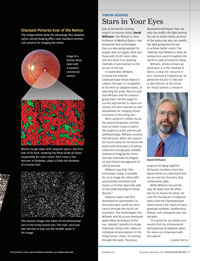In Review
 David Williams (Photo: Adam Fenster)
David Williams (Photo: Adam Fenster)One of the world’s leading experts on human vision, David Williams—the William G. Allyn Professor of Medical Optics—has pioneered new technologies that are improving eyesight for people who are legally blind and those with 20/20 vision alike. And he’s done it by applying methods of astronomers to the terrain of the eye.
In September, Williams received the António Champalimaud Vision Award in Lisbon, Portugal, in recognition of his work on adaptive optics. In awarding the prize, the jury said that Williams and his research group have “set the stage for current approaches to vision correction and have opened up new possibilities for imaging retinal structures in the living eye.”
With a prize of 1 million euros, the award recognizes contributions to vision research and is the largest in vision science and ophthalmology. Williams receives half the prize, which will support his future research; he shares the award with developers of optical coherence tomography, another method of imaging the retina that has improved the diagnosis and clinical management of retinal disease.
Williams says that “this technology makes it possible for us to image the retina with unsurpassed resolution and moves us further down the path to the understanding of retinal disease.”
Adaptive optics was first developed by astronomers so that telescopes could see more clearly through the Earth’s atmosphere. The technologies that Williams and his group developed apply these techniques to the eye, making it possible to image individual retinal cells—down to individual photoreceptors in the living human retina—by looking through the pupil. The group developed techniques that not only can modify the light leaving the eye to obtain better pictures of the retina but also can modify the light going into the eye to achieve better vision. The methods that Williams’s team developed are used throughout the world in Lasik procedures today.
Williams, whose primary appointment is in the Institute of Optics, is dean for research in Arts, Sciences & Engineering. He joined the faculty in 1981 and is also director of the Center for Visual Science, a research program bringing together 30 faculty members from five departments to understand how we see and the disorders that compromise sight.
While Williams has led the way, he notes that the effort was by no means his alone. He calls the discoveries in adaptive optics that the Champalimaud Award honors the “work of many graduate students, postdoctoral fellows, and colleagues over two decades.
“It is great for our whole community that the achievements and potential of adaptive optics for vision are showcased with this award.”
—Leonor Sierra

